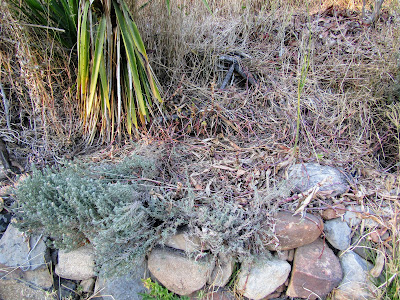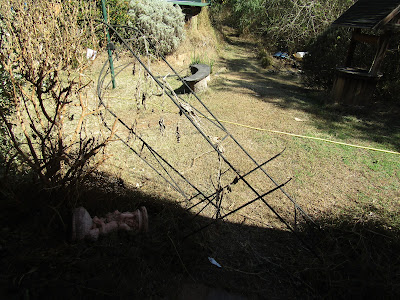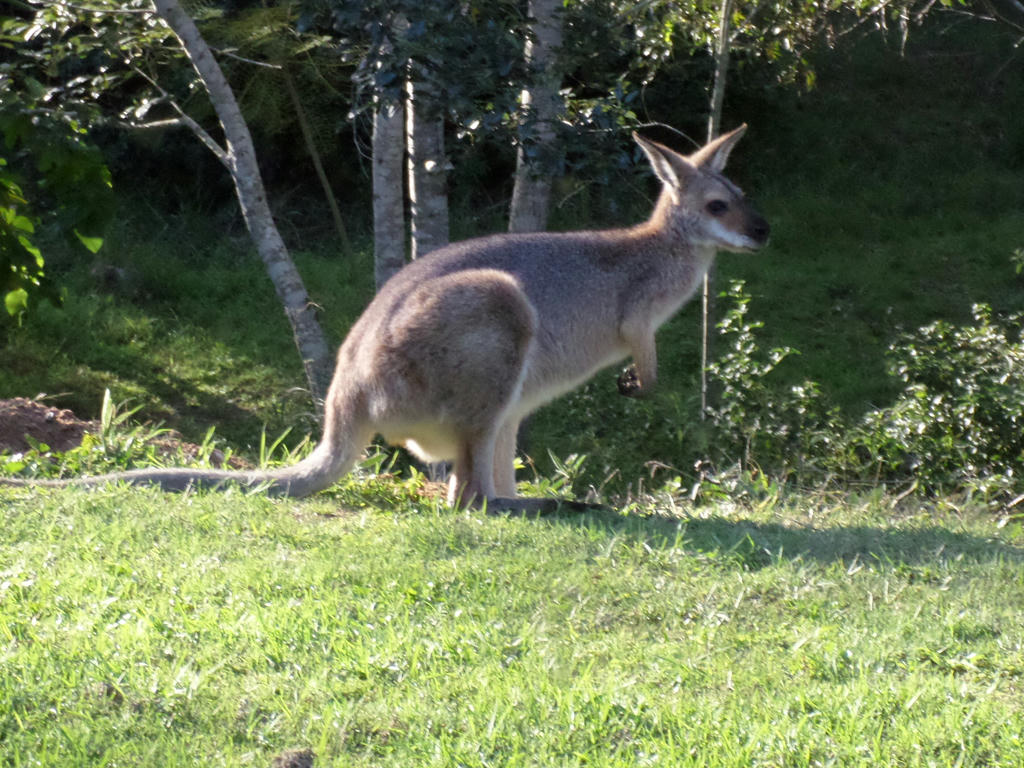What this post is about however, is the reality for the native animals which are always affected too. I notice this, every winter/spring, there's a protracted dry spell. It was made more prominent this particular year, because of a lack of average rainfall throughout autumn/winter. The higher than average winter temps, didn't help either - sucking what moisture there was in the ground, out.
We've been raided...
Consequently, there is very little feed around for the native animals. Which means, they invade what we have. This is my shade house, which I can normally leave the door open. The culprit was a kangaroo. Not only can I tell by the scats they left behind, but they also failed to eat the silverbeet they pulled down from the shelf. A hare would have devoured these.
Kangaroos go looking for foods they favour, which is why the first time they took these pots down, they didn't eat them. The second time, they did. Because by then, the food was getting even more scarce.
...and again
The roos raided my shade house several times, before I got in the habit of closing the door again. I'm surprised they didn't take the sweet potato leaves, after having devoured the rest in the garden. I expect they were nervous coming into my shade house (enclosed space) and didn't stay longer than they had to.
Lavender and bromeliads, 2017
Lavender & bromeliads, 2018
What the kangaroos have done this year, which they haven't done before, is take out my bromeliads. Right down to the stub. I hope these will come back. The reason I know it was kangaroos, is how they squashed my lavender plant, with their big feet and long tails. I never knew they ate bromeliads, until this year.
Normally the pigeon pea trees I plant around the place, helps feed the kangaroos through this dry part of the year - but they were already taxing that supply early. The rains failed to green the grass, so they stripped the pigeon peas. A lack of rain has stopped the pigeons peas from growing more leaves. So now the kangaroos are desperate.
Damaged
So much so, disputes are now happening between males, as they're forced to find food in our limited backyard. I came out to feed the chickens one morning, and found the garden arch, had been knocked over.
I didn't know what it was as first - wondering if the wind had blown it down? Upon closer inspection, however, I found two, tell-tale signs, it was male kangaroos.
Exhibit (a)
The bars which slipped into each segment of the archway, were bent. This took a lot of force, to knock the bar out, and bend it at the same time. Which means applied force took the archway down, and, apart.
I managed to put it back together, with the help of some pliers, however it will never be the same again. One of the sides, bends inwards now. Never mind, it's just "stuff" which can be replaced. There was still a mystery to solve, however.
Exhibit (b)
Speckled all over the ground nearby, was grey kangaroo fur. Which confirmed what I already suspected - this was a fight between two male bucks. I have not seen this in our yard before. Normally one big male, owns our yard and we see very few males, otherwise. But now they're in competition for food, and not just females. So we're seeing more males trying to enter our yard to eat.
Male buck
I'm not sure if this was the victor or loser of that particular confrontation, but I spotted him eating the grass we irrigate with grey water, a few days afterwards. It's meant for our chicken, but plenty of native animals take advantage also.
This particular buck, had a half-closed eye - a war wound, perhaps? The kangaroos are in the worse shape, I've ever seen them in the decade living here. Not just the males, but the females especially.
We all miss the green!
This picture was taken June 2015, from this post - where I wrote about the view from my kitchen window. Notice the green grass in winter, and the joey she's growing in her pouch?
Not this year though. I haven't seen any female kangaroos, sporting baggy pouches. It's part of their biology to naturally terminate a pregnancy in a drought. So even if an egg is fertilised, it won't survive. If there are kangaroo mamma's out there, they aren't visiting our yard.
Click to enlarge
We also found a flock of juvenile King Parrots, taking advantage of the chicken feed, left behind, after moving the chicken tractor. Also a couple of Topknot pigeons. Parrots don't normally like to come down on the ground like this. They much prefer the safety of snacking from a tree limb.
But when in drought, this is what the native wildlife, have to do to survive. Risk being eaten, in order to eat.
Lookout, for the flock, to warn of danger
It's a very different view in cities, where the native wildlife subsist exclusively on the accumulation of resources. The numbers are also reduced, due to heavy competition with humans and infrastructure. Birds and possums have managed to adapt more, to increase their numbers in suburbia though.
All this to say, it's a lot harder where nature is all you've got to subsist off. We haven't got much for the wildlife to share, when it's not growing out there. We've been filling the birdbath daily, and an extra bowl we put at ground level, for the kangaroos. I imagine, if it wasn't for the water, we probably wouldn't be that popular.
So my hope is, the predicted rain comes though this weekend, and gives everything/everyone a hearty drink.












Oh dear Chris. Frustrating to have so much damage to your garden but I love your gentle approach to co-habitating with the wildlife, father then going to battle with them. I hope you manage to get lots of rain this weekend and that the native grasses in the district quickly shoot out. Such a dreadful season for so many. xx
ReplyDeleteYeah, the "stuff" I can live with being trashed. It's the living things I care for. They're are, after all, what make this property, what it is. They are my co-gardeners. I have high hopes for the rain. It will arrive, eventually. :)
DeleteHope you get the rain too, Chris, just as I hope we don't get any more here! The last 3 months here we've had twice the average rainfall and this month is shaping up to be the same. I've been clearing lots of fuel out of the bush and have had very little chance to burn it off. It has also been one of the coldest winters I can remember, but maybe it's a sign that I'm just getting older!
ReplyDeleteMaybe that's a good sign for our approaching storm season, Bev? Maybe we'll be so lucky to have that amount of rain too. I know for the southern parts of Australia, winter is the highest averages for precipitation. For the north, it's summer. Fingers crossed! And it's great to hear some parts of Australia are getting the rain. :)
DeleteDrought is so tough on people and animals alike. When we drove from Canberra through to Batemans Bay recently, through really dry country with little to no green anywhere, I was so saddened by sheer numbers of dead wombats and kangaroos along sections of road. They are coming in to try to find food along the roadside ditches and getting hit by cars and trucks :(
ReplyDeleteHere at our place, it's dry too. I have birdbaths I fill daily and shallower trays of water for smaller creatures. I try to have flowers for bees and birds to forage in. The little creek down the hill isn't flowing and sections are dried up so we are now getting birds like ducks waddling up here.
I think it's a great attitude you have to be understanding of the hardships wildlife face too and to be accepting of some of the negatives of them coming in to your garden. Meg
Sadly Meg, our highway (10 minutes drive away) is the same. Only it's kangaroos and their joey's. They're having to migrate more, to get to the food, and crossing roads is part of that treacherous journey. Also, the feed is good, because the swales or spoon drains in the country, catch what water there is to be had, by the side of the road. It's hard to see the reality, of their mortality, in such high numbers.
DeleteMaybe it's good for us to see though. To recognise we can do more in our own yards. I know when the rains arrive, I'm going to double my efforts to plant more pigeon pea seeds. I've stockpiled quite a few from the trees before the kangaroos stripped them. It's great to hear you're supplying water to the wildlife as well. We gotta love on our native animals, where we are able to. :)
Chris, I also hope the rain comes this weekend as it is so dry. I have been putting out water each day for any wildlife around here. It has dried up so quickly in that dreadful wind though. Thankfully it is warming up a bit now as I got the lurgy when it was really cold and windy so felt quite miserable with nowhere around to get out of the wind so I could sit in the sun apart from in my car :-)
ReplyDeleteI know Toowoomba would've had more wind than we get here. Because on top of the mountain, you get very little protection. Which is great for summer cooling, but not so great for winter chills! I hope you get better soon Chel. I know after writing this post, I suddenly got hit with what my daughter had. I thought I was in the clear, lol. Not to worry though, David is collecting a box of organic veg from Birdsong farm, today. Which I'm REALLY looking forward to.
DeleteIt's great to hear, you're able to put water out for the wildlife too. :)
I wonder if you got some rain Chris? Do you think there are more roos over the past few years? And what do you think about culling? It sure is dry and makes everything such a battle.
ReplyDeleteOh my Sally, I forgot to reply to your post! I remember reading it, but thought I replied to it? I do believe the rains we've enjoyed, prior to this dry has increased the roo population. I've certainly noticed it here. So that when the first protracted dry spell arrives, you see a lot of hungry mouths and the plants get decimated.
DeleteI do see a place for culling, although I don't think I'm the person for doing it, lol. We actually purchased some kangaroo jerky for a relative, for Christmas. It was really nice! I wouldn't like to see their numbers exploited though. Better to wild harvest in problem areas. I wouldn't like to see the same treatment as emu and crocodile farming.